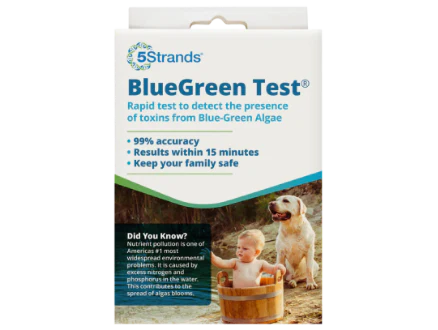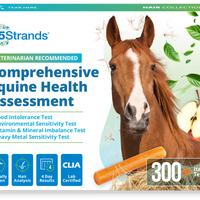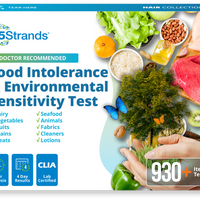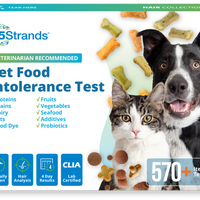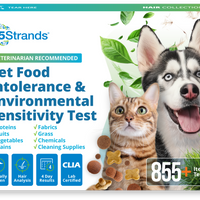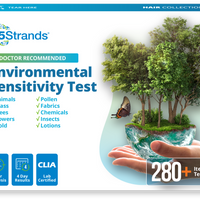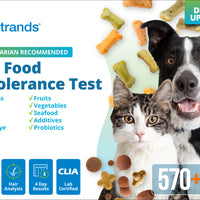Most of the time, people use the term FOOD ALLERGY interchangeably with FOOD INTOLERANCE. While some of the symptoms may be similar, a true allergy and an intolerance are completely different.
The term “food allergy” causes most people to think about the common peanut or shellfish allergy that causes someone’s tongue to swell, throat to close up, or anaphylaxis shock leading to death. This situation described is actually the worst case scenario that can happen, but you may be surprised to learn that it is the kind of reaction that actually happens the least! Only about 2% of the population will have a “true” allergic reaction like described above. An allergy occurs when the body mistakes an ingredient in your food as harmful and creates a defense system to fight against it. Your body looks at this food item as an enemy, and it puts out antibodies to fight against this invader.
On the other hand, food intolerances root from the body’s digestive system. When the body cannot tolerate certain food items, irritation in the digestive tract occurs because the foods cannot be broken down to complete digestion. This can then manifest into a large variety of symptoms.
What are the key differences between an Allergy and an Intolerance?
1. The number one difference between an allergy and an intolerance is that an allergy involves the immune system, and an intolerance involves the digestive system.
- An allergy starts when your immune system mistakes a normally harmless substance for a dangerous invader. The immune system then produces antibodies that remain on the alert for that particular allergen. When you're exposed to the allergen again, these antibodies can release a number of immune system chemicals, such as histamine, that cause allergy symptoms.
- An intolerance involves the digestive system. Symptoms are caused by the body not producing enough of a digestive enzyme to break down that particular food item
2. The easiest way to tell the difference between an allergy and an intolerance is that the symptoms of an allergy are fast acting or immediate. The symptoms caused by an intolerance are more delayed. An intolerance symptom can take anywhere from 30 minutes to 72 hours to manifest.
3. An important difference between an allergy and an intolerance is the level of severity. The symptoms of a food allergy can be life threatening, whereas the symptoms of an intolerance will only make you feel bad.
- In severe cases, a food allergy can lead to anaphylaxis, which can cause tightening of airways, swelling in throat, dizziness, loss of consciousness, and even death if untreated.
- With a food intolerance, it is never life threatening. You may not feel well in one way or another, but the reaction does not have the possibility of death.
4. With an allergy, it can only take a trace amount of the reactive food to elicit a response. An intolerance reaction would not happen with only a trace amount. It varies by person, but an intolerance reaction tends to occur only after a decent amount of that item and can take multiple days of build up eating the same food.
- Even if the previous reactions when consuming a food have been mild, a person with a food allergy is at risk for the next reaction to be life threatening. Eating even a microscopic amount of the food could lead to anaphylaxis. If you have a known allergy, you will want to consider carrying an EpiPen at all times.
- With intolerances, small amounts of food can typically be tolerated. Symptoms may be “dose” dependent. This will also vary from one individual to another.
5. An allergy is usually lifelong, while intolerances can be temporary.
- Once an individual has developed an allergy (IgE) response, it will be considered an allergy for the rest of their life.
- Once an elimination of the items you are intolerant to has been removed from your diet, your body can heal itself. After 6-8 weeks, you may be able to introduce the item back into your diet slowly and with moderation without experiencing any symptoms. Intolerances can change over time, so it is important to pay attention to your symptoms.
What are the symptoms of an Allergy and an Intolerance?
Please note that some of these symptoms may overlap between an allergy and an intolerance. The only way to know for sure is to test for the IgE antibodies to determine if you have a true allergy to a particular item.
The symptoms that are most prevalent with food intolerances are as follows:
Digestive issues may be common such as:
- Bloating
- Gas
- Nausea
- Abdominal pain
- Constipation
-
Diarrhea
There are many more symptoms that can arise. Other symptoms include:
- Headaches
- Cough
- Runny nose
- Itchy eyes or ears
- Heartburn/indigestion
- Eczema
- Rashes
- Brain fog
- Fatigue
- Depression
- Anxiety
The symptoms most prevalent with a food allergy are as follows:
- Hives
- Vomiting
- Tingling/itching of the mouth and tongue
- Swelling of the lips, tongue, or throat
- Wheezing
- Coughing
- Sneezing
- Runny nose
- Swollen/watery eyes
- Congestion
- Difficulty breathing
- Anaphylaxis
- Itching
- Rashes
- Severe diarrhea
- Abdominal pain
How do you diagnose the difference?
ALLERGY:
-
Skin Prick test- This is the most common way of determining environmental allergens. They do test for some food items, but the panels are very limited. This procedure is typically done at an allergist's office. The doctor will prick or inject your skin with a serum that contains small amounts of the proteins found in potential allergens. If you develop a raised bump (hive) at the test location on your skin, this will indicate that you have an allergy to that particular allergen.

- IgE analysis- The true way of diagnosing an allergy is done by examining the immunological response (typically through a blood test). Your blood sample must be sent off to a medical laboratory to be examined. When exposed to a certain antigen or allergen, the body’s immune system makes an antibody called immunoglobulin E (IgE). The blood sample will be examined for these antibodies.
- Oral Food Challenge- An oral food challenge involves feeding the patient increasing doses of food protein under medical supervision to see if they react to the food protein and to measure how much of the protein they can eat before reacting. If the patient can eat the whole challenge dose without reacting, they aren’t allergic to that food protein.
INTOLERANCE:
- The Elimination Diet- This method is considered the “Gold Standard.” It involves eliminating the food for 6-8 weeks that is suspected of causing the unwanted symptoms and then see if the symptoms lessen. This method can be extremely time consuming and lengthy because you are doing this with one food at a time typically.
- Hair analysis testing- 5Strands Affordable Testing tests for intolerances or the NON-IgE responses. Currently, this is the most effective way to determine food intolerances. This type of health assessment does not require blood, but rather a simple hair sample! 5Strands takes your hair sample and analyzes the frequency. The unique frequency of the hair sample is then matched to frequency patterns of over 600 food items. This type of testing is conducted using bioresonance technology. Even if you have never ingested or been exposed to an item, bioresonance is able to measure the severity of intolerance reaction you would have when consuming that item. You now know what foods to consume and eliminate during your elimination diet. The 5Strands Food Intolerance Test can provide extreme clarity on next steps at a fraction of the cost when compared to other methods. Having a direction and a road map to better health is one of the more difficult parts of a manual elimination diet. While the hair analysis testing still requires conducting an elimination plan, you have a starting point instead of shooting in the dark with which items you should eliminate and consume.
- Genetic testing- This method is used to see if the individual has the capability of producing certain digestive enzymes or not.
Are there other types of reactions than just allergies or intolerances?
In fact, there are several types of reactions that the body can have. A lot of times, the word “sensitivity” is also used. There is a hypersensitivity chart that can break down the 4 main types of reactions.
-
Type I: On the hypersensitivity chart, type 1 is categorized as an allergy. This refers to an IgE reaction. As we mentioned above, an allergy is an immediate reaction that occurs when the body is triggered by an innocuous foreign substance. A type I hypersensitivity can only be determined through blood or skin prick testing.
-
Type II: This is categorized as a cytotoxic reaction, or antibody dependent reaction. It refers to an IgM or in some cases, IgG. In this instance, an antibody binds to an antigen on the target cell which is actually a host cell that is perceived as foreign. Type II hypersensitivities can be determined through blood or saliva testing.
-
Type III: This reaction is immune complex and categorized as an IgG reaction. In a type III reaction, the antibody binds to an antigen forming a circulating immune complex. This reaction can also be conducted through blood or saliva testing.
- Type IV: Type IV is categorized as an intolerance, which is an antibody independent, cell mediated hypersensitivity. It does not involve antibodies, but instead involves T-cells attracting and activating macrophages and will cause an inflammatory response. There is a delayed reaction. This type of reaction can be determined through hair sample testing using bioresonance.

As you can see, reactions your body can have are a lot more complicated than most people think. Usually the word “allergy” is used as an umbrella term. However, the more accurate way to describe the different types of reactions is “hypersensitivity”.
What are the most common foods that people can be allergic to or intolerant to?
When it comes to allergies, 90% of all allergic reactions result from a total of eight foods: milk, eggs, fish, shellfish, peanuts, tree nuts, wheat, and soybeans. Most of these foods are easily identified and able to be avoided. However, it is much more difficult to avoid eggs, wheat, and soy because they are added to so many food products. Reading ingredients is a MUST!

Food Intolerances include a much wider variety of foods and specific compounds found in foods. You can actually develop an intolerance to just about anything! The most common intolerances that people experience are gluten, dairy, lactose, caffeine, salicylates (in fruits and vegetables), nightshades, (tomatoes, bell peppers, potatoes, eggplant), sulfites, food additives, preservatives, food colorings, and flavorings, Amines, (tyramine, histamine, etc), chocolate, and citrus fruits.
Even though there is statistical evidence of the most common allergies and intolerances, it is important to remember that you are a unique individual so your allergies or intolerances will be unique as well! Just because your family member is allergic or intolerant to an ingredient, that does not mean that you will be as well. Even identical twins can have completely different allergies and intolerances. So what are yours? :)



